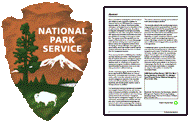United States National Park Service

United States National Park Service: Publications
Date of this Version
2008
Abstract
We believe that this means preserving the full complement of native flora and fauna, and allowing these species to live their lives without interference from humans. It also means preserving unruly, unpredictable processes such as fires, floods, and insect outbreaks that have shaped park landscapes and, over the eons, helped create wild species themselves.
Since its inception, the “leave nature alone” philosophy has had strong advocates within the Park Service and among its friends. In the 1920s, for example, George Wright (NPS scientist), Joseph Grinnell (Zoology professor at the University of California–Berkeley), and Charles C. Adams (at the College of Forestry, Syracuse, New York) argued that national parks should be ruled chiefly by natural processes. Although Wright felt that active management might be needed in “combating the harmful effects of human influence,” Wright and Grinnell argued forcefully against fencing the bison for display, feeding the bears, and killing predators in Yellowstone (Pritchard 1999).


Comments
Published in Weber, Samantha, and David Harmon, eds. 2008. Rethinking Protected Areas in a Changing World: Proceedings of the 2007 GWS Biennial Conference on Parks, Protected Areas, and Cultural Sites. Hancock, Michigan: The George Wright Society.